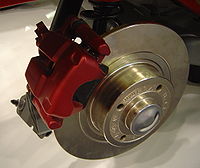
Photo from wikipedia
A low-frequency squeal that occurs due to the coupling phenomena of various vibrational modes in a disc brake system may cause annoyance to passengers. In an effort to remove the… Click to show full abstract
A low-frequency squeal that occurs due to the coupling phenomena of various vibrational modes in a disc brake system may cause annoyance to passengers. In an effort to remove the irritating low-frequency squeal of the disc brake, we carried out complex eigenvalue analysis and investigated the contribution ratio of each part to the occurrence of squealing. To this end, we developed a reliable and accurate finite element (FE) model of each brake part and compared it to the model test results. Throughout the complex eigenvalue analysis for the FE models, all unstable modes and corresponding frequencies in the brake system were calculated. The dominant parts that contributed largely to the squealing of the brake system were also elicited by the component contribution factor (CCF) analysis. Parts such as the disc, carrier, pad, and knuckle, were determined as large contributors to squealing. To reduce squealing, the tie-bar shape and the groove shape around the disc hub were optimized by FE-based shape optimization. A new disc with an optimal groove and a new tie-bar were manufactured, and dynamo squeal tests were conducted for a comparison to the numerical prediction. A fairly good correlation was observed between the experimental and numerical analysis results.
Journal Title: International Journal of Precision Engineering and Manufacturing
Year Published: 2018
Link to full text (if available)
Share on Social Media: Sign Up to like & get
recommendations!